Satellite-Based Background Aerosol Optical Depth Determination via Global Statistical Analysis of Multiple Lognormal Distribution
Abstract
1. Introduction
2. Materials and Methods
2.1. Satellite AOD Data
2.2. AERONET Data
2.3. MERRA-2 Aerosol Chemical Data
2.4. Multiple Lognormal Distribution Fitting for AOD Histogram
2.5. Determination of the Best Cutoff Percentile for BAOD
2.6. IDW Interpolation
3. Results
3.1. VIIRS DB AOD Comparison with AERONET AOD
3.2. Global AOD Distribution
3.3. Preliminary BAOD from Multiple Lognormal Fitting
3.4. Best Cutoff Percentile of the Lowest AOD for Background Aerosol
4. Discussion
4.1. Variation of BAOD to Different Satellite Datasets and Seasons
4.2. BAOD Determination from an Aerosol Chemical Perspective
4.3. Case Studies of BAOD Applying on Satellite Aerosol Type Discrimination
4.4. Definitions and Identification of Background Aerosols
5. Conclusions
Author Contributions
Funding
Data Availability Statement
Acknowledgments
Conflicts of Interest
References
- Cai, H.; Yang, Y.; Luo, W.; Chen, Q. City-level variations in aerosol optical properties and aerosol type identification derived from long-term MODIS/Aqua observations in the Sichuan Basin, China. Urban Clim. 2021, 38, 100886. [Google Scholar] [CrossRef]
- Zhao, B.; Wang, Y.; Gu, Y.; Liou, K.-N.; Jiang, J.H.; Fan, J.; Liu, X.; Huang, L.; Yung, Y.L. Ice nucleation by aerosols from anthropogenic pollution. Nat. Geosci. 2019, 12, 602–607. [Google Scholar] [CrossRef] [PubMed]
- Hsu, N.C.; Lee, J.; Sayer, A.M.; Kim, W.; Bettenhausen, C.; Tsay, S.C. VIIRS Deep Blue Aerosol Products Over Land: Extending the EOS Long-Term Aerosol Data Records. J. Geophys. Res. Atmos. 2019, 124, 4026–4053. [Google Scholar] [CrossRef]
- Crippa, P.; Sullivan, R.C.; Thota, A.; Pryor, S.C. Sensitivity of Simulated Aerosol Properties Over Eastern North America to WRF-Chem Parameterizations. J. Geophys. Res. Atmos. 2019, 124, 3365–3383. [Google Scholar] [CrossRef]
- Gao, J.; Li, Y.; Xie, Z.; Wang, L.; Hu, B.; Bao, F. Which aerosol type dominate the impact of aerosols on ozone via changing photolysis rates? Sci. Total Environ. 2023, 854, 158580. [Google Scholar] [CrossRef] [PubMed]
- Zhang, H.; Kondragunta, S.; Laszlo, I.; Liu, H.; Remer, L.A.; Huang, J.; Superczynski, S.; Ciren, P. An enhanced VIIRS aerosol optical thickness (AOT) retrieval algorithm over land using a global surface reflectance ratio database. J. Geophys. Res. Atmos. 2016, 121, 10717–10738. [Google Scholar] [CrossRef]
- Bao, F.; Li, Y.; Gao, J. Carbonaceous aerosols remote sensing from geostationary satellite observation, Part I: Algorithm development using critical reflectance. Remote Sens. Environ. 2023, 287, 113459. [Google Scholar] [CrossRef]
- Dubovik, O.; Holben, B.; Eck, T.F.; Smirnov, A.; Kaufman, Y.J.; King, M.D.; Tanré, D.; Slutsker, I. Variability of absorption and optical properties of key aerosol types observed in worldwide locations. J. Atmos. Sci. 2002, 59, 590–608. [Google Scholar] [CrossRef]
- Chen, A.; Zhao, C.; Shen, L.; Fan, T. Influence of aerosol properties and surface albedo on radiative forcing efficiency of key aerosol types using global AERONET data. Atmos. Res. 2023, 282, 106519. [Google Scholar] [CrossRef]
- Eom, S.; Kim, J.; Lee, S.; Holben, B.N.; Eck, T.F.; Park, S.-B.; Park, S.S. Long-term variation of aerosol optical properties associated with aerosol types over East Asia using AERONET and satellite (VIIRS, OMI) data (2012–2019). Atmos. Res. 2022, 280, 106457. [Google Scholar] [CrossRef]
- Xia, X.; Che, H.; Zhu, J.; Chen, H.; Cong, Z.; Deng, X.; Fan, X.; Fu, Y.; Goloub, P.; Jiang, H.; et al. Ground-based remote sensing of aerosol climatology in China: Aerosol optical properties, direct radiative effect and its parameterization. Atmos. Environ. 2016, 124, 243–251. [Google Scholar] [CrossRef]
- Petrenko, M.; Kahn, R.; Chin, M.; Limbacher, J. Refined Use of Satellite Aerosol Optical Depth Snapshots to Constrain Biomass Burning Emissions in the GOCART Model. J. Geophys. Res. Atmos. 2017, 122, 10983–11004. [Google Scholar] [CrossRef]
- Chen, Q.-X.; Shen, W.-X.; Yuan, Y.; Tan, H.-P. Verification of aerosol classification methods through satellite and ground-based measurements over Harbin, Northeast China. Atmos. Res. 2019, 216, 167–175. [Google Scholar] [CrossRef]
- Zhang, L.; Li, J. Variability of Major Aerosol Types in China Classified Using AERONET Measurements. Remote Sens. 2019, 11, 2334. [Google Scholar] [CrossRef]
- Zheng, Y.; Che, H.; Xia, X.; Wang, Y.; Yang, L.; Chen, J.; Wang, H.; Zhao, H.; Li, L.; Zhang, L.; et al. Aerosol optical properties and its type classification based on multiyear joint observation campaign in north China plain megalopolis. Chemosphere 2021, 273, 128560. [Google Scholar] [CrossRef] [PubMed]
- Kalapureddy, M.C.R.; Kaskaoutis, D.G.; Ernest Raj, P.; Devara, P.C.S.; Kambezidis, H.D.; Kosmopoulos, P.G.; Nastos, P.T. Identification of aerosol type over the Arabian Sea in the premonsoon season during the Integrated Campaign for Aerosols, Gases and Radiation Budget (ICARB). J. Geophys. Res. Atmos. 2009, 114, D17203. [Google Scholar] [CrossRef]
- Lee, J.; Kim, J.; Song, C.H.; Kim, S.B.; Chun, Y.; Sohn, B.J.; Holben, B.N. Characteristics of aerosol types from AERONET sunphotometer measurements. Atmos. Environ. 2010, 44, 3110–3117. [Google Scholar] [CrossRef]
- Cappa, C.D.; Kolesar, K.R.; Zhang, X.; Atkinson, D.B.; Pekour, M.S.; Zaveri, R.A.; Zelenyuk, A.; Zhang, Q. Understanding the optical properties of ambient sub- and supermicron particulate matter: Results from the CARES 2010 field study in northern California. Atmos. Chem. Phys. 2016, 16, 6511–6535. [Google Scholar] [CrossRef]
- Cao, C.; Xiong, J.; Blonski, S.; Liu, Q.; Uprety, S.; Shao, X.; Bai, Y.; Weng, F. Suomi NPP VIIRS sensor data record verification, validation, and long-term performance monitoring. J. Geophys. Res. Atmos. 2013, 118, 11664–11678. [Google Scholar] [CrossRef]
- Sayer, A.; Hsu, N.; Bettenhausen, C.; Jeong, M.-J. Validation and uncertainty estimates for MODIS Collection 6 “Deep Blue” aerosol data. J. Geophys. Res. Atmos. 2013, 118, 7864–7872. [Google Scholar] [CrossRef]
- Chen, X.; Ding, H.; Li, J.; Wang, L.; Li, L.; Xi, M.; Zhao, L.; Shi, Z.; Liu, Z. Remote sensing retrieval of aerosol types in China using geostationary satellite. Atmos. Res. 2024, 299, 107150. [Google Scholar] [CrossRef]
- Vadde, S.; Kalluri, R.O.R.; Gugamsetty, B.; Kotalo, R.G.; Kajjer Virupakshappa, U.; Akkiraju, B.; Thotli, L.R.; Lingala, S.S.R.; Rapole, J.K. Classifying aerosol type using in situ and satellite observations over a semi-arid station, Anantapur, from southern peninsular India. Adv. Space Res. 2023, 72, 1109–1122. [Google Scholar] [CrossRef]
- Khademi, F.; Bayat, A. Classification of aerosol types using AERONET version 3 data over Kuwait City. Atmos. Environ. 2021, 265, 118716. [Google Scholar] [CrossRef]
- Zhao, H.; Gui, K.; Ma, Y.; Wang, Y.; Wang, Y.; Wang, H.; Zheng, Y.; Li, L.; Zhang, L.; Che, H.; et al. Climatological variations in aerosol optical depth and aerosol type identification in Liaoning of Northeast China based on MODIS data from 2002 to 2019. Sci. Total Environ. 2021, 781, 146810. [Google Scholar] [CrossRef]
- Zhou, P.; Wang, Y.; Liu, J.; Xu, L.; Chen, X.; Zhang, L. Difference between global and regional aerosol model classifications and associated implications for spaceborne aerosol optical depth retrieval. Atmos. Environ. 2023, 300, 119674. [Google Scholar] [CrossRef]
- Cao, C.; Luccia, F.J.D.; Xiong, X.; Wolfe, R.; Weng, F. Early On-Orbit Performance of the Visible Infrared Imaging Radiometer Suite Onboard the Suomi National Polar-Orbiting Partnership (S-NPP) Satellite. IEEE Trans. Geosci. Remote Sens. 2014, 52, 1142–1156. [Google Scholar] [CrossRef]
- Eck, T.F.; Holben, B.N.; Giles, D.M.; Slutsker, I.; Sinyuk, A.; Schafer, J.S.; Smirnov, A.; Sorokin, M.; Reid, J.S.; Sayer, A.M.; et al. AERONET Remotely Sensed Measurements and Retrievals of Biomass Burning Aerosol Optical Properties During the 2015 Indonesian Burning Season. J. Geophys. Res. Atmos. 2019, 124, 4722–4740. [Google Scholar] [CrossRef]
- Giles, D.M.; Sinyuk, A.; Sorokin, M.G.; Schafer, J.S.; Smirnov, A.; Slutsker, I.; Eck, T.F.; Holben, B.N.; Lewis, J.R.; Campbell, J.R.; et al. Advancements in the Aerosol Robotic Network (AERONET) Version 3 database—Automated near-real-time quality control algorithm with improved cloud screening for Sun photometer aerosol optical depth (AOD) measurements. Atmos. Meas. Tech. 2019, 12, 169–209. [Google Scholar] [CrossRef]
- Qiao, Y.; Ji, D.; Shang, H.; Xu, J.; Xu, R.; Shi, C. The Fusion of ERA5 and MERRA-2 Atmospheric Temperature Profiles with Enhanced Spatial Resolution and Accuracy. Remote Sens. 2023, 15, 3592. [Google Scholar] [CrossRef]
- Liu, C.; Yin, Z.; He, Y.; Wang, L. Climatology of Dust Aerosols over the Jianghan Plain Revealed with Space-Borne Instruments and MERRA-2 Reanalysis Data during 2006–2021. Remote Sens. 2022, 14, 4414. [Google Scholar] [CrossRef]
- Ignatov, A.; Holben, B.; Eck, T. The lognormal distribution as a reference for reporting aerosol optical depth statistics; Empirical tests using multi-year, multi-site AERONET Sunphotometer data. Geophys. Res. Lett. 2000, 27, 3333–3336. [Google Scholar] [CrossRef]
- Povey, A.; Grainger, R. Towards more representative gridded satellite products. IEEE Geosci. Remote Sens. Lett. 2018, 16, 672–676. [Google Scholar] [CrossRef]
- Łukaszyk, S. A new concept of probability metric and its applications in approximation of scattered data sets. Comput. Mech. 2004, 33, 299–304. [Google Scholar] [CrossRef]
- Wylie, D.; Jackson, D.L.; Menzel, W.P.; Bates, J.J. Trends in Global Cloud Cover in Two Decades of HIRS Observations. J. Clim. 2005, 18, 3021–3031. [Google Scholar] [CrossRef]
- Sayer, A.M.; Hsu, N.C.; Lee, J.; Kim, W.V.; Dutcher, S.T. Validation, stability, and consistency of MODIS collection 6.1 and VIIRS version 1 Deep Blue aerosol data over land. J. Geophys. Res. Atmos. 2019, 124, 4658–4688. [Google Scholar] [CrossRef]
- Reid, J.S.; Hyer, E.J.; Johnson, R.S.; Holben, B.N.; Yokelson, R.J.; Zhang, J.; Campbell, J.R.; Christopher, S.A.; Di Girolamo, L.; Giglio, L.; et al. Observing and understanding the Southeast Asian aerosol system by remote sensing: An initial review and analysis for the Seven Southeast Asian Studies (7SEAS) program. Atmos. Res. 2013, 122, 403–468. [Google Scholar] [CrossRef]
- Zhao, B.; Jiang, J.H.; Diner, D.J.; Su, H.; Gu, Y.; Liou, K.-N.; Jiang, Z.; Huang, L.; Takano, Y.; Fan, X.; et al. Intra-annual variations of regional aerosol optical depth, vertical distribution, and particle types from multiple satellite and ground-based observational datasets. Atmos. Chem. Phys. 2018, 18, 11247–11260. [Google Scholar] [CrossRef] [PubMed]
- Gao, M.; Han, Z.; Tao, Z.; Li, J.; Kang, J.E.; Huang, K.; Dong, X.; Zhuang, B.; Li, S.; Ge, B.; et al. Air quality and climate change, Topic 3 of the Model Inter-Comparison Study for Asia Phase III (MICS-Asia III)—Part 2: Aerosol radiative effects and aerosol feedbacks. Atmos. Chem. Phys. 2020, 20, 1147–1161. [Google Scholar] [CrossRef]
- Bibi, H.; Alam, K.; Bibi, S. In-depth discrimination of aerosol types using multiple clustering techniques over four locations in Indo-Gangetic plains. Atmos. Res. 2016, 181, 106–114. [Google Scholar] [CrossRef]
- Schmeisser, L.; Andrews, E.; Ogren, J.A.; Sheridan, P.; Jefferson, A.; Sharma, S.; Kim, J.E.; Sherman, J.P.; Sorribas, M.; Kalapov, I.; et al. Classifying aerosol type using in situ surface spectral aerosol optical properties. Atmos. Chem. Phys. 2017, 17, 12097–12120. [Google Scholar] [CrossRef]
- Shin, S.K.; Tesche, M.; Noh, Y.; Müller, D. Aerosol-type classification based on AERONET version 3 inversion products. Atmos. Meas. Tech. 2019, 12, 3789–3803. [Google Scholar] [CrossRef]
- Pokharel, M.; Guang, J.; Liu, B.; Kang, S.; Ma, Y.; Holben, B.N.; Xia, X.A.; Xin, J.; Ram, K.; Rupakheti, D.; et al. Aerosol Properties Over Tibetan Plateau from a Decade of AERONET Measurements: Baseline, Types, and Influencing Factors. J. Geophys. Res. Atmos. 2019, 124, 13357–13374. [Google Scholar] [CrossRef]
- Yu, X.; Kumar, K.R.; Lü, R.; Ma, J. Changes in column aerosol optical properties during extreme haze-fog episodes in January 2013 over urban Beijing. Environ. Pollut. 2016, 210, 217–226. [Google Scholar] [CrossRef] [PubMed]
- Xia, X. Variability of aerosol optical depth and Angstrom wavelength exponent derived from AERONET observations in recent decades. Environ. Res. Lett. 2011, 6, 044011. [Google Scholar] [CrossRef]
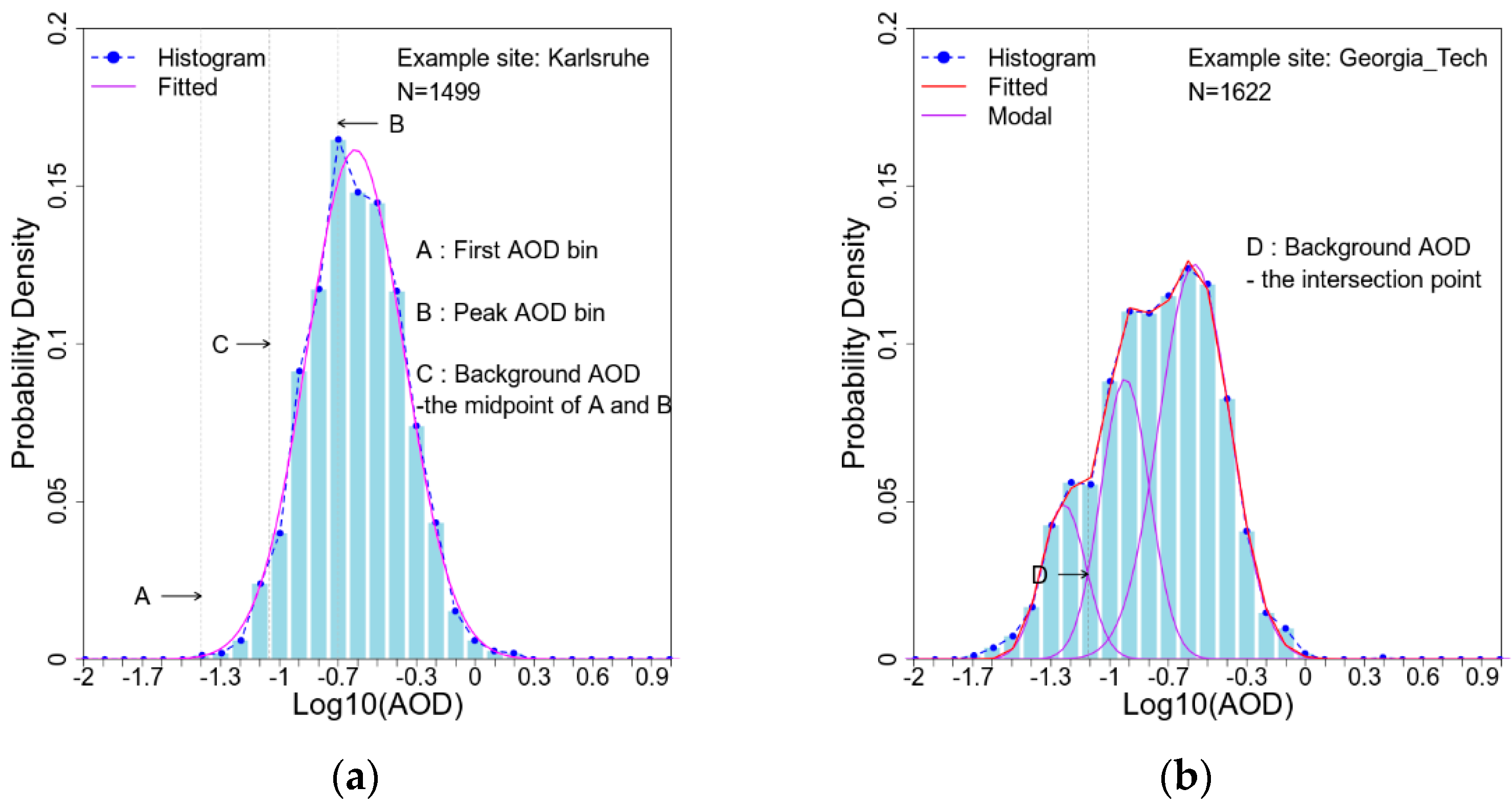
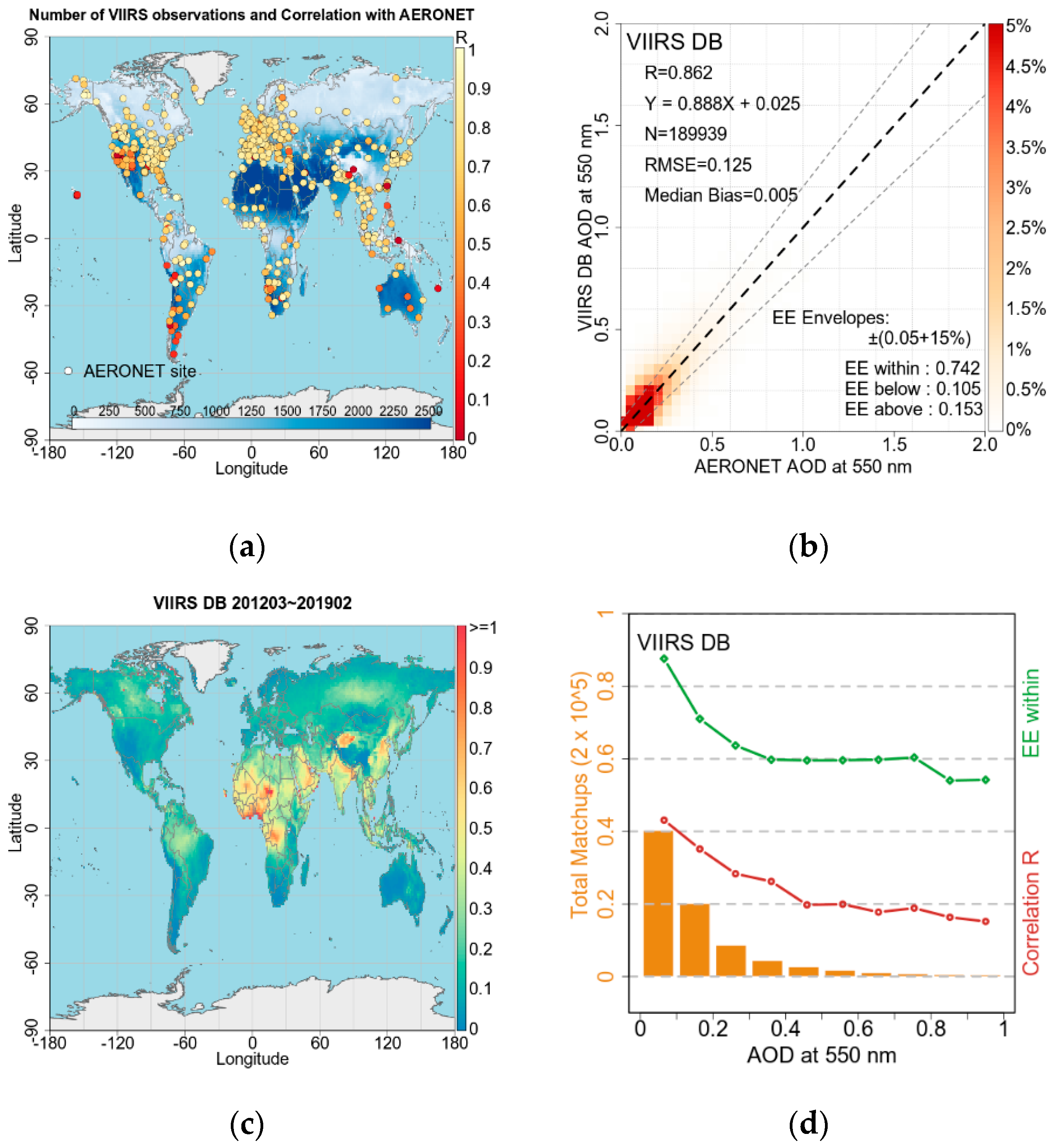



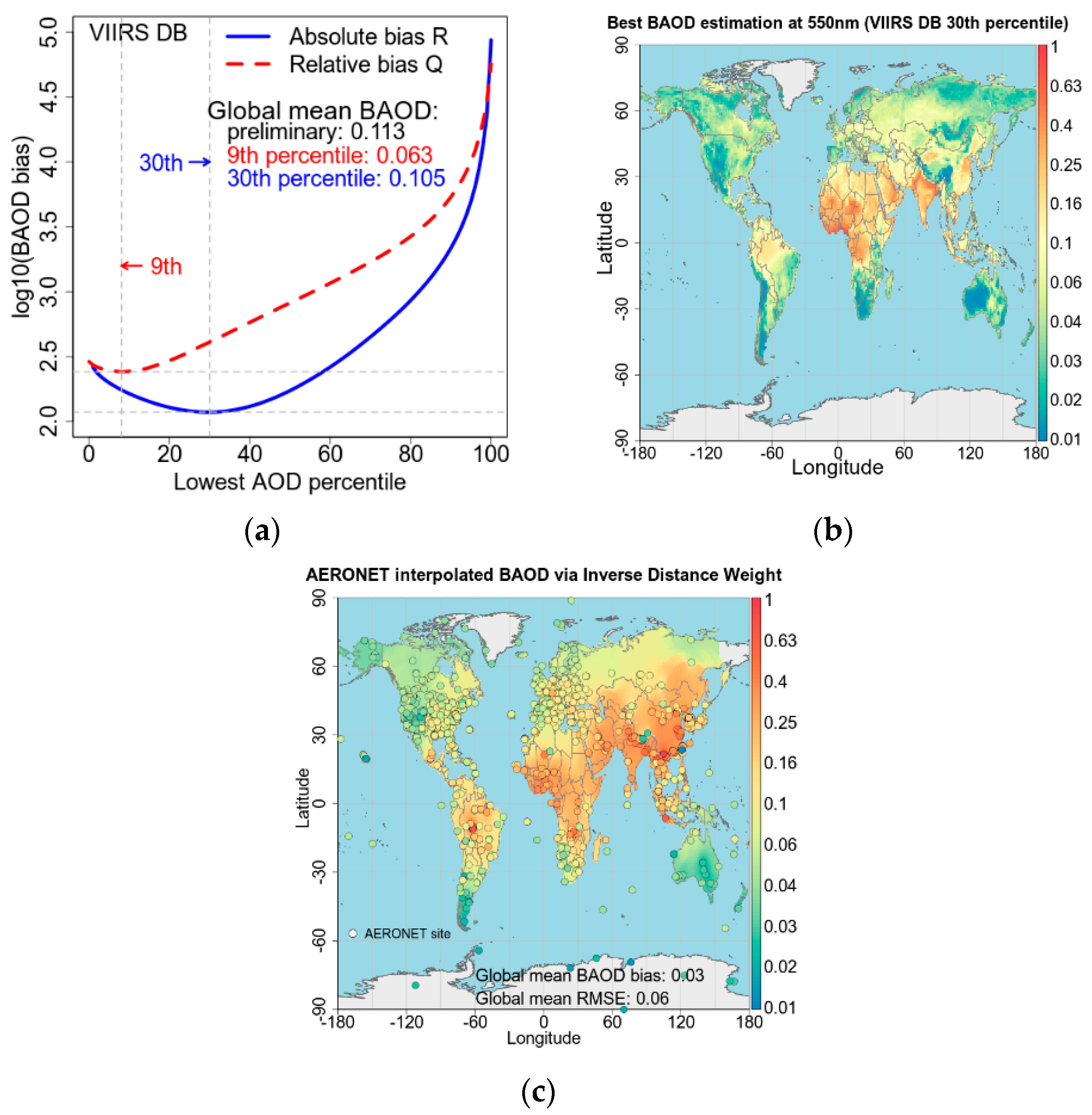

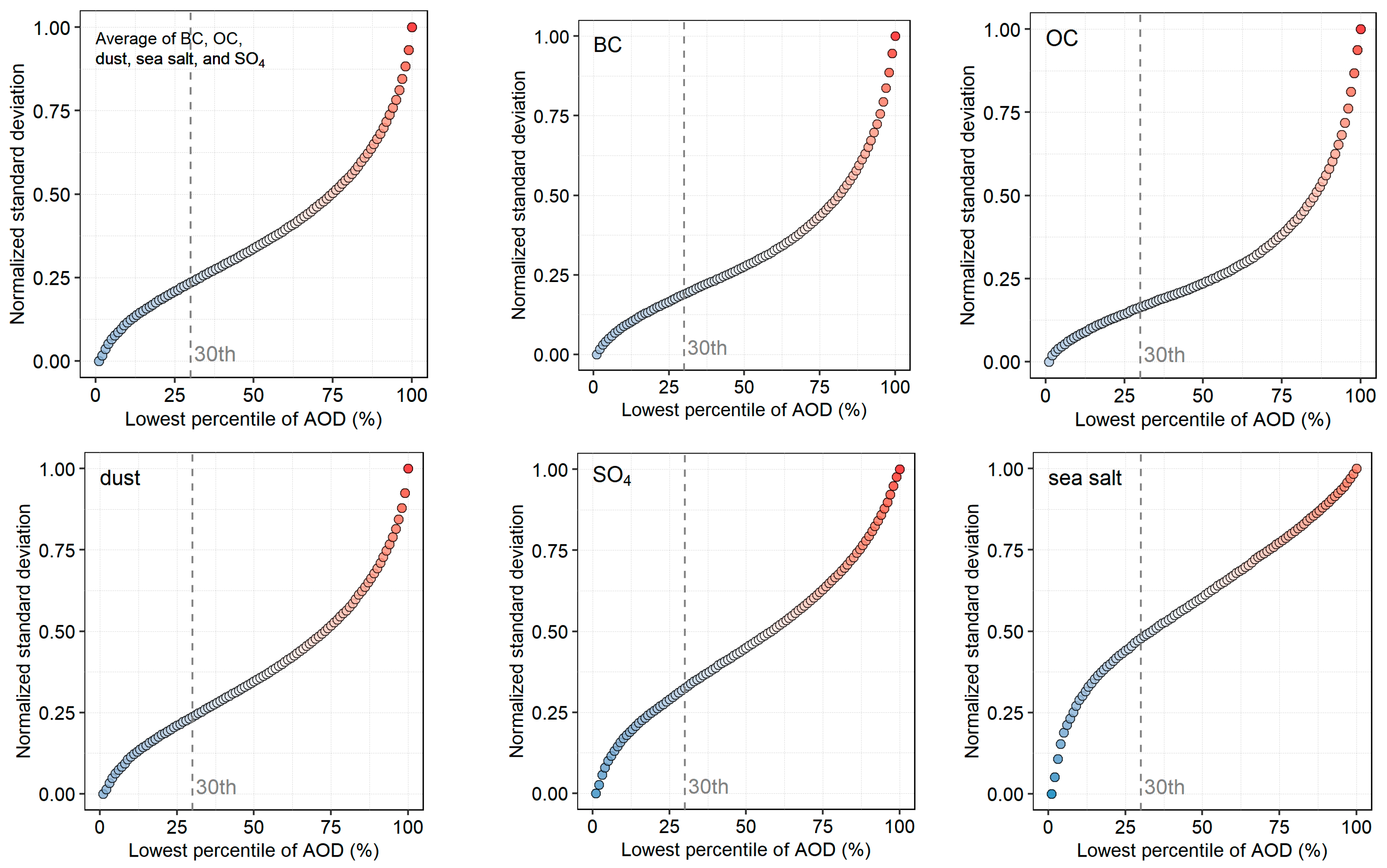



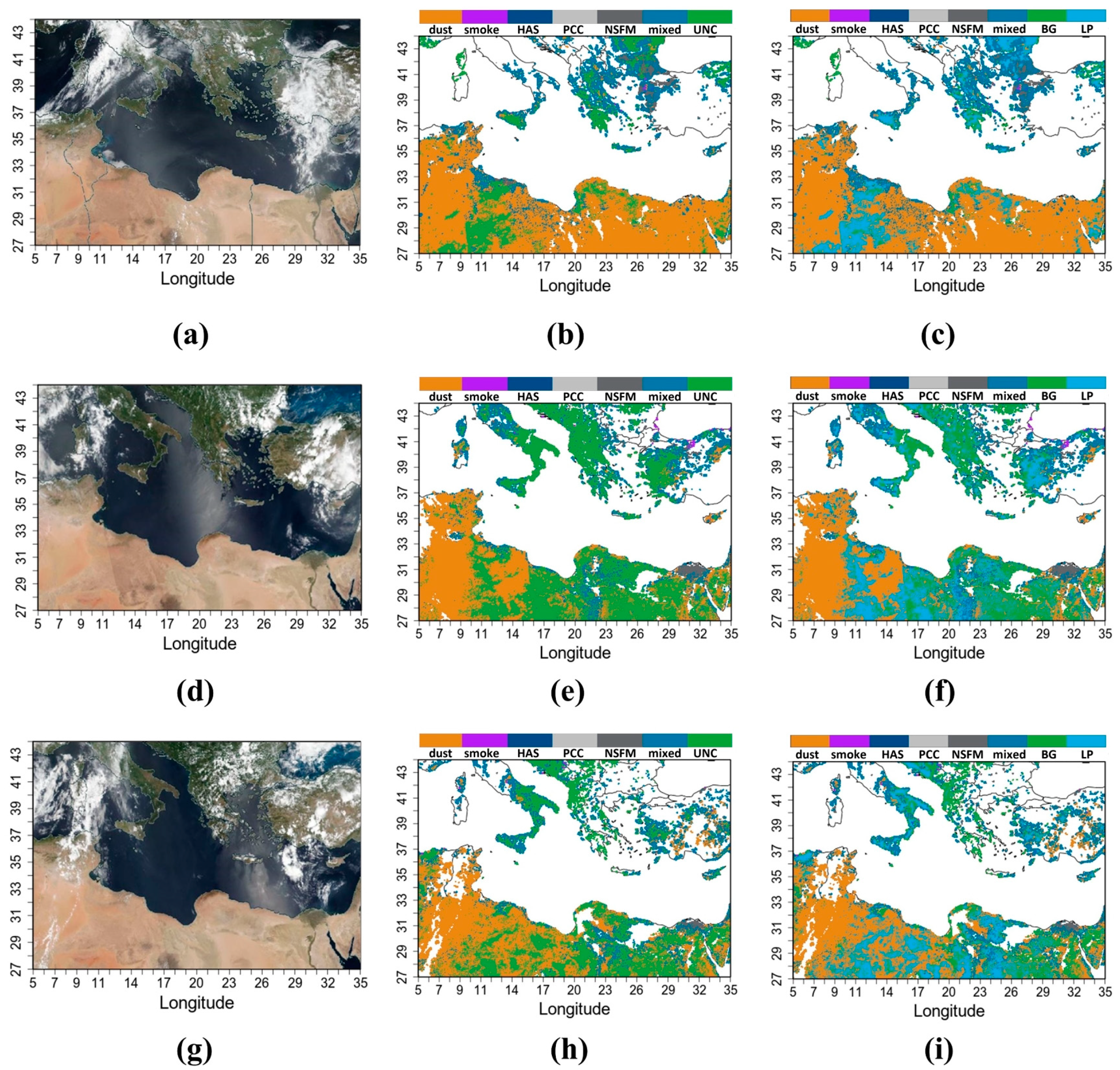

| Dataset | Year 2012–2019 | Month | ||||||||||||
|---|---|---|---|---|---|---|---|---|---|---|---|---|---|---|
| January | February | March | April | May | June | July | August | September | October | November | December | Average | ||
| VIIRS DB | 30% | 33% | 32% | 29% | 27% | 27% | 27% | 28% | 28% | 27% | 32% | 33% | 31% | 29.5% |
| MOD DB | 28% | 31% | 27% | 26% | 24% | 26% | 22% | 25% | 25% | 24% | 25% | 29% | 31% | 26.3% |
| MOD DT | 32% | 31% | 28% | 27% | 28% | 30% | 27% | 27% | 27% | 30% | 28% | 32% | 31% | 28.8% |
| MOD DTB | 31% | 27% | 27% | 27% | 26% | 27% | 25% | 26% | 27% | 38% | 27% | 28% | 28% | 26.9% |
| MYD DB | 28% | 30% | 30% | 28% | 29% | 27% | 27% | 30% | 28% | 30% | 28% | 29% | 32% | 28.9% |
| MYD DT | 33% | 30% | 28% | 29% | 31% | 29% | 29% | 28% | 29% | 32% | 32% | 32% | 33% | 30.2% |
| MYD DTB | 32% | 29% | 28% | 28% | 29% | 30% | 29% | 29% | 29% | 30% | 28% | 28% | 29% | 28.8% |
| MISR | 32% | - | - | - | - | - | - | - | - | - | - | - | - | - |
| Average | 30.8% | 30.1% | 28.6% | 27.7% | 27.7% | 28.0% | 26.6% | 27.6% | 27.6% | 28.7% | 28.6% | 30.0% | 30.7% | 28.5% |
Disclaimer/Publisher’s Note: The statements, opinions and data contained in all publications are solely those of the individual author(s) and contributor(s) and not of MDPI and/or the editor(s). MDPI and/or the editor(s) disclaim responsibility for any injury to people or property resulting from any ideas, methods, instructions or products referred to in the content. |
© 2024 by the authors. Licensee MDPI, Basel, Switzerland. This article is an open access article distributed under the terms and conditions of the Creative Commons Attribution (CC BY) license (https://creativecommons.org/licenses/by/4.0/).
Share and Cite
Chen, Q.-X.; Huang, C.-L.; Dong, S.-K.; Lin, K.-F. Satellite-Based Background Aerosol Optical Depth Determination via Global Statistical Analysis of Multiple Lognormal Distribution. Remote Sens. 2024, 16, 1210. https://doi.org/10.3390/rs16071210
Chen Q-X, Huang C-L, Dong S-K, Lin K-F. Satellite-Based Background Aerosol Optical Depth Determination via Global Statistical Analysis of Multiple Lognormal Distribution. Remote Sensing. 2024; 16(7):1210. https://doi.org/10.3390/rs16071210
Chicago/Turabian StyleChen, Qi-Xiang, Chun-Lin Huang, Shi-Kui Dong, and Kai-Feng Lin. 2024. "Satellite-Based Background Aerosol Optical Depth Determination via Global Statistical Analysis of Multiple Lognormal Distribution" Remote Sensing 16, no. 7: 1210. https://doi.org/10.3390/rs16071210
APA StyleChen, Q.-X., Huang, C.-L., Dong, S.-K., & Lin, K.-F. (2024). Satellite-Based Background Aerosol Optical Depth Determination via Global Statistical Analysis of Multiple Lognormal Distribution. Remote Sensing, 16(7), 1210. https://doi.org/10.3390/rs16071210








